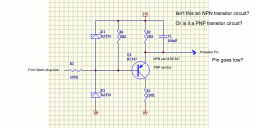Tachometer circuit problem
 Capt. Quirk
Posts: 872
Capt. Quirk
Posts: 872
I have a capacitive pick-up circuit that was copied from a tach/egt unit.
The problem is the transistor used in the circuit. The part # is a npn,
but the symbol used is a pnp.
Another problem is the circuit itself, IMO, it is an NPN style, and the
output to the propeller should be low?
++ moderator, I may need to ask more questions related directly to
the propeller.
Thanks
Bill M.
The problem is the transistor used in the circuit. The part # is a npn,
but the symbol used is a pnp.
Another problem is the circuit itself, IMO, it is an NPN style, and the
output to the propeller should be low?
++ moderator, I may need to ask more questions related directly to
the propeller.
Thanks
Bill M.



Comments
rapidly to the -ve pulse from the lead.
I am curious because of the 220k resistor below the transistor. Is that part of a voltage divider?
When it is triggered, do you think the voltage will drop enough (less than ~1.7v) for the propeller
to recognize the change?
Bill M.
BTW, I found an itty bitty coil inside that MSD pickup.
healthy input negative going spike will simply pull the base down fast and charge the cap directly via
the base-emitter junction.
The tach is bouncing around high and low.
I am going to try to add another 100K resistor to the end of the pick-up wire.
A few commercial capacitive pick-ups use a resistor on the end of their pick-up
wire.
It also occurs to me that either the counter is doing a poor job of logging a high
signal to the Propeller pin. Or the pick-up circuit is possibly supplying a poor
pulse to the Propeller?
Right now I am just trying to measure rpm on my Lawnmower. But yes, it is for a
jetski, but not the MSD. The MSD is much easier thanks to the forum!
This is one part of a JetSki data acquisition system that will monitor exhaust gas temp
(EGT), cylinder head temp (CHT), rpm, acceleration, throttle position (TPS), and log it
to a large spi eeprom.
After I am finished with the JetSki data acquisition system, I want to create an object
without the EGT, and TPS. CHT's under the spark plug is easy, combined with cht
guidelines, it will make jetting much easier. EGT's, imo, are too difficult for most people
to use.
By the first of the year, I want to include a 18v transistor ignition.
But since I started the tachometer project, I have discovered that my understanding
of what the Propeller counters are capable of was incorrect. I would prefer the counters
to add clock tics to the phsa while the propeller pin is either low or high. Not simply
add the number of high or low pulses to the phsa.
Bill M.
'' ================================================================================================= '' '' File....... Tach demo v.0.3C.spin '' Purpose.... 4-bit LCD tachometer '' Author..... Bill M. '' Started.... '' Updated.... '' '' ================================================================================================= {{ Notes: 1. Baseline code v.0.1 that displays a make-believe rpm range. 2. Incorperate Motor Minder into tach demo v.0.2 To_Do List: I need to average rpm results and refresh the rpm value at a given time I need to be able to change rpm average and refresh time rate in the "Con" section. 3. tach demo v.0.3 Cnvert motor minder to read only phsa register after a 60 sec delay. Also add code for calculating acceleration. 4. tach demo v.0.3B 5. Tach demo v.0.3C Needed delays between lcd operations. They worked. 6. The backlight is too bright 7. The rpm bounces around too much, Need to try 100K resistor on the end of the sensor wire. 8. Another possibility is the counters are doing a poor job of counting the short positive pulses, or they are capturing more than one positive pulse per revolution. Future: Add Baseline v1.1.1 Max31856.spin and put it into it's own cog. Convert to 4x20 display Add 512 mbyte spi eeprom. Add ADC for TPS. }} con ' _clkmode = xtal1 + pll16x _clkmode = xtal1 + pll8x ' _xinfreq = 5_000_000 ' use 5MHz crystal ' _xinfreq = 6_250_000 ' use 6.25MHz crystal _xinfreq = 10_000_000 LCD_D4 = 3 LCD_RS = 2 LCD_RW = 1 LCD_E = 0 LCD_BL = -1 ' no backlight LCD_COLS = 8 ' lcd configuration LCD_ROWS = 2 tach_pin = 7 ' shaft encoder - Propeller pin ' floating point variables for display OBJ lcd : "jm_lcd4_ez" PUB Main | rps, rpm, acc, rps_old lcd.start(-1, LCD_E, LCD_COLS, LCD_ROWS) ' bl on P16, 16x2 LCD lcd.move_to(1,1) ' define custom characters lcd.str(@lable1) lcd.move_to(5,1) lcd.str(@lable2) lcd.move_to(1,2) ' define custom characters lcd.str(@lable3) waitcnt(clkfreq * 2 + cnt) ' wait 2 seconds to check lcd display. dira[tach_pin]~ ' Set as an Input. 'start revolution counter in counter A frqa := 1 ' Determines the value added every time a pos edge occurs. ctra := 0 ' stop counter phsa := 0 ' zero counter ctra := (%01010 << 26 ) | (tach_pin) ' count positive going edges in counter A rps_old := 1000 ' one time only value to prevent subtracting zero. repeat phsa := 0 waitcnt(clkfreq + cnt) rps := phsa if phsa > 0 ' Prevent lcd from displaying bad data while engine is off rpm := rps * 60 acc := rps - rps_old lcd.move_to(5,1) waitcnt(clkfreq / 10_000 + cnt) lcd.rjdec(rpm, 4, "0") waitcnt(clkfreq / 1000 + cnt) lcd.move_to(5,2) waitcnt(clkfreq / 10_000 + cnt) lcd.rjdec(acc, 4, "0") '' Need to determine if + or - symbols are displayed?? rps_old := rps DAT lable1 byte "RPM", 0 lable2 byte "1250", 0 lable3 byte "ACC", 0 lable4 byte "Pto", 0LCD operations normally need about 37us before accepting another character except in the case of home/clear commands which require 1.5ms. Spin is slow enough that it doesn't need any extra delay for normal operations, you only need to add that delay to the home/clear. My LCD driver in Tachyon controls the brightness of the backlight through a simple PWM on the background timer cog which does something similar to the tick interrupt routine on most micros in tracking time, timers, time of day, events etc.
The capacitive pick-up is supplied with 3.3v, should the hysteresis band be increased
to provide a wider gap? Perhaps V_lo closer to ~.8v and V_hi closer to ~2.3v?
Or is that something best found through experimenting.
Since I am using the counters, can I bypass the AN015 pasm program and change the
counter to %01011 "POSEDGE detector w/ feedback" and use the same wiring diagram
in the app note with the 2 resistors using the Bpin as the feedback pin, and Apin as the
input pin?
I have never understood what the "Feedback" on a counter was used for.
I would like to learn more about that. Can you point me towards something I can read? I was
planing on using the counters to control the dwell time and ignition timing on the transistor
ignition.
Thanks
Moderator: Frequently my schematic in my first post does not show up, when I am
logged in, on this page. It doesn't matter if I am using chrome, firefox, or internet explorer?
I like the parallax LCD along with it's object. The Jonny Mac object is good for the cheap LCD's but a little more work to use. The Parallax LCD is very good but a little pricey.
The HEF40106 Hex inverting Schmitt trigger isn't enough?
Does that mean the parallax appnote an015 will most likely be insufficient?
I bought the resistors I needed today, and will test tomorrow.
One other question. Looking at my circuit (does it show up in your browser?)
Does the voltage that is applied to the base (from the sensor wire), combine with the
3.3v on the emitter side of the transistor to create a rising edge logic that is greater
than 3.3v?
Bill M.
On the transistor ignition prototype, I used 2 parallax hall sensors with a magnet glued
to the back of the sensor to read my reluctor. Many watercraft use a wasted spark system,
but this one uses individual coils for the 2 cylinder engine.
The 2 hall sensors are combined for each cylinder-coil; to create a greater degree resolution
similar to a 4 stroke with a position sensor on the crank and cam. The reluctor (and truth table)
is designed to signal which cylinder will fire, and when to start the dwell. The truth table and
software determines when to cut the dwell and create the spark.
The problem with this set-up is the need to count clock tics for 180' to 360 degrees to determine
rpm.
Currently I see calculating rpm on a single or 1/2 revolution as my greatest problem, because
it may not be accurate enough?
Hopefully I can just slow down the clock speed or add a fudge factor to the program
BM.